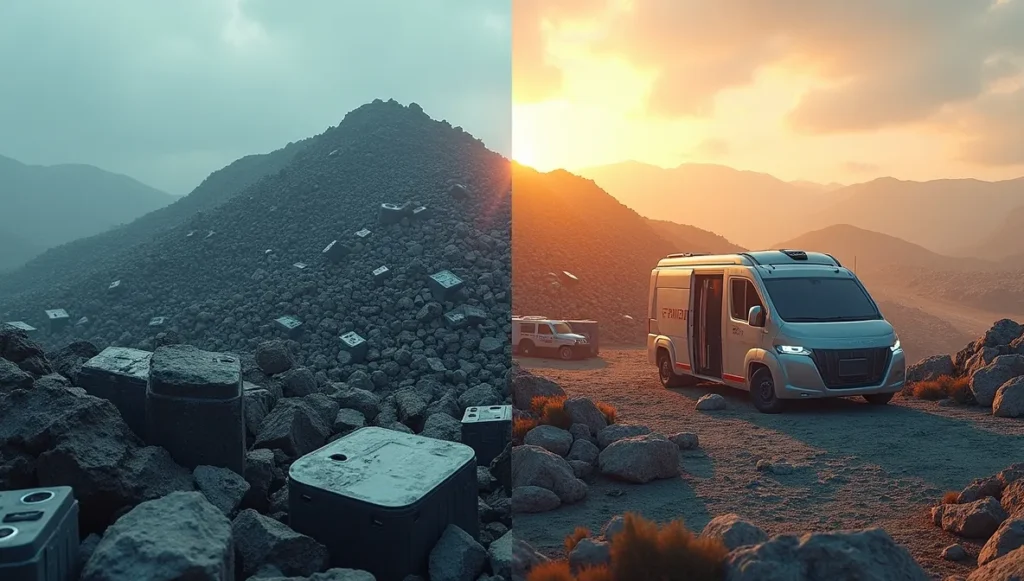“Electric vehicles slash tailpipe emissions by 60%… but they’re not perfect. From toxic mining to ‘green’ tire waste, here are 5 rarely discussed EV Environmental Impacts or downsides—and how to combat them.”
1. Lithium & Cobalt Mining: The Dirty Secret of Batteries
The Problem:
- Mining 1 ton of lithium consumes 500,000 gallons of water and emits 15 tons of CO₂ (2024 Journal of Cleaner Production).
- Cobalt mines in Congo use child labor (64% of global supply).
How to Fix It:
🔋 Choose EVs with LFP batteries (Tesla Model 3 RWD, BYD Seal) – no cobalt, less lithium.
♻️ Support battery recycling startups like Redwood Materials (Ford’s partner) or Li-Cycle.
🌊 Advocate for deep-sea mining bans (Norway’s 2024 loophole).
Did You Know?
Recycling EV batteries could cut mining demand by 70%—but today, only 5% are recycled (learn how to fix this in our circular economy guide).
2. EV Tire Microplastics: The Invisible Pollutant
The Problem:
- Heavier EVs shed 20% more microplastics than gas cars (Emissions Analytics 2025).
- Tire dust now causes 78% of ocean microplastics (IUCN).
How to Fix It:
🛞 Switch to low-wear tires like Michelin’s EV-specific range.
🐢 Drive smoothly—hard acceleration wears tires 50% faster.
📢 Pressure brands to develop plant-based tires.
Shocking Stat:
In cities, tire pollution now outweighs tailpipe emissions.
3. Battery Recycling Gaps (And Why ‘Green’ Labels Lie)

The Problem:
- Most recyclers recover just 40% of materials (DOE 2024).
- “Recyclable” batteries often end up in landfills due to shipping costs.
How to Fix It:
🗺️ Use Call2Recycle.org to find local drop-offs.
⚖️ Demand right-to-repair laws (EU’s 2025 battery passport helps).
🔋 Buy EVs with modular batteries (e.g., NIO’s swap stations).
Key Quote:
“‘Recyclable’ doesn’t mean ‘recycled’—just like these common landfill offenders.”
4. Grid Strain: When Your ‘Clean’ EV Runs on Coal
The Problem:
- Charging in coal-heavy states like Wyoming doubles emissions vs. wind-powered Norway.
- 60% of U.S. fast chargers still rely on fossil fuels (2025 IEA report).
How to Fix It:
🌙 Charge overnight—when wind/solar peak (use apps like Optiwatt).
☀️ Install solar + V2G tech (Ford F-150 Lightning can power your home).
💡 Lobby for utility-scale renewables (2025 Inflation Reduction Act $$).
Hope Spot:
50% of U.S. charging now aligns with renewable peaks.
5. The Carbon Footprint Illusion (Manufacturing vs. Driving)
The Problem:
- Building an EV emits 70% more CO₂ than a gas car (Volvo 2024 LCA study).
- Takes 20,000+ miles to “break even” (varies by grid cleanliness).
How to Fix It:
🔄 Buy used EVs (avoid new manufacturing impact).
⏳ Keep your EV 10+ years—the longer it runs, the greener it gets.
🚗 Support car-sharing (1 shared EV replaces 8 gas cars).
Conclusion: EVs Still Win—But Transparency Matters
“EVs are 80% cleaner over their lifetime—but ignoring these gaps slows progress. Share this post to push for better batteries, tires, and recycling. P.S. Which impact surprised you most? Comment below!






